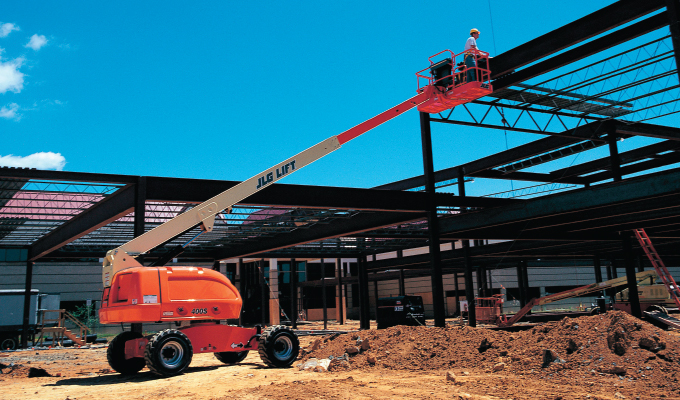By Jennifer Stiansen
Confusing and complicated. These are two words that can frequently describe the selection of equipment in construction that is suitable for working at height. With so many types of machines available—each with a variety of models, specifications, and attachments—how do you know which is the best fit for your job? On top of that, the pressures of intense deadlines can sometimes drive contractors to assume another piece of equipment already on site will make due. However, using a machine that is not designed for the work is inefficient and dangerous, says Brad Mellott, product training specialist for JLG Industries.
“If they’ve chosen the wrong machine for the job, the ultimate end result could be injuries or fatalities,” he says.
With the proper planning and site assessments, contractors can avoid these significant consequences by selecting access equipment that will help keep their crews productive and safe. In this article, find out what questions you need to ask and how to appropriately evaluate which machine is the right one for the task at hand.
TELEHANDLER VS. CRANE
Increasingly, OEMs are introducing higher-capacity telehandlers as crane alternatives. Telehandlers can often reduce costs, save time, and maneuver more easily around congested jobsites. So, when can a telehandler serve as an appropriate substitute for a crane? Mellott says there are five main factors to consider, which include:
- Weight of the load
- Distance to the target landing area
- Ground conditions
- Site access constraints
- Proximity to the public
There are several ways to determine if the telehandler is in fact capable of placing the load at the destination, Mellott says.
The first does not require the use of the machine at all. The telehandler’s load chart features an X and Y axis for distance from the front tires and height needed for placement. Using the load chart and a tape measure, a determination can be made to see if the machine can safely place the load.
The other way is through a dry run procedure. “The dry run procedure is a practice run of the lift or pick being performed but with no load on the forks. Using the indicators on the side of the boom, the operator completes a dry run placement and compares it to the load chart to determine if the machine can safely place the load,” Mellott says.
Something else that contractors need to consider is that with the right attachments, some telehandlers can essentially turn into cranes. Though OSHA provided guidance on this in 2014, Mellott says questions about this issue come up in nearly every training class he teaches.
OSHA directive CPL 02-01-057 states, “Any forklift that lifts with a boom (including the boom of the forklift itself) and a hoist would be covered by the requirements of the cranes and derricks standard. For example, a variable reach forklift would also be covered by the cranes standard if it is configured with a hoist and used like a crane.”
This is important because that means the telehandler now requires a certified crane operator for its use, Mellott says.
BOOM LIFT VS. TELEHANDLER WITH WORK PLATFORM
Not only is it possible for a telehandler to transform into a crane, it can also perform work like a boom lift when paired with a personnel platform. When is this option a viable replacement?
First, Mellott says contractors must ensure the work platform attachment is OEM-approved. “All attachments, including the personnel work platform, must be an approved attachment,” he says. “They can’t just stand on a pallet on the end of the forks.”
Contractors can check to see if an attachment is approved on the JLG website. “On the JLG website, you can select a specific machine and locate the list of approved attachments for that machine,” Mellott says.
Second, the user must also take into account the distance to the work area, ground conditions, site constraints, and proximity to the public. “Typically, the reach on a telehandler is not nearly the reach that a boom lift can offer,” he says. Telehandlers with personnel work platforms have the potential to pose additional safety concerns that contractors should be aware of, Mellott says. This is because the telehandler operator is located in the cab with personnel in the work platform, as opposed to a boom lift, where the operator is in the platform.
Telehandler operators need to maintain a clear line of communication and visibility with the personnel in the work platform, Mellott says.
MAKING THE RIGHT CHOICE
In addition to working with your rental company’s customer service representatives on your access equipment selection, digital tools can also assist in your decision-making.
Introduced at ConExpo-Con/Agg 2020, JLG’s Augmented Reality app allows users to view whether equipment can fit in an actual work area. Currently, boom lifts and scissor lifts are available on the app, with plans to add low-level access solutions and telehandlers by the end of summer 2021.
CLOSING THOUGHT
While many of these considerations may seem like common sense, Mellott says it’s important that access equipment users have a thorough understanding of what is unsafe and where to draw that line.
Being able to use resources from JLG’s Augmented Reality app allows users to view whether equipment can fit in an actual work area. And, there are other resources like the BIM Library, and an equipment selector tool on the JLG website to match options to specific tasks.
About the Author:
Jennifer Stiansen is the director of marketing for JLG Industries. For more, visit, www.jlg.com.
Modern Contractor Solutions, September 2021
Did you enjoy this article?
Subscribe to the FREE Digital Edition of Modern Contractor Solutions magazine.



